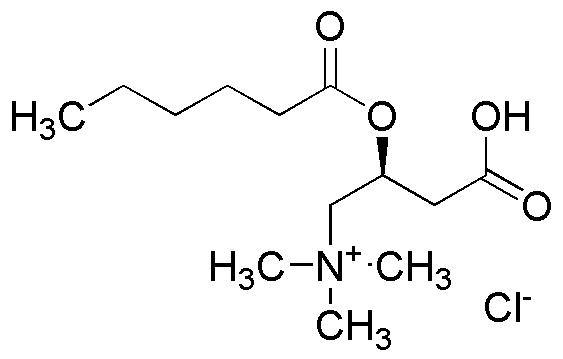Hexanoyl-L-carnitine chloride is widely utilized in research focused on:
- Metabolic Studies: This compound plays a crucial role in studying fatty acid metabolism, helping researchers understand energy production and storage in cells.
- Cardiovascular Health: It is used in investigations related to heart function and health, particularly in how fatty acids influence cardiac metabolism and performance.
- Weight Management: Researchers explore its potential in weight loss and obesity studies, as it may aid in the transportation of fatty acids into mitochondria for energy use.
- Neuroprotective Research: The compound is being studied for its effects on brain health, particularly in neurodegenerative diseases, due to its role in cellular energy metabolism.
- Pharmaceutical Development: It is a key ingredient in formulations aimed at enhancing drug delivery systems, particularly for lipid-based therapies, improving bioavailability and efficacy.
General Information
Properties
Safety and Regulations
Applications
Hexanoyl-L-carnitine chloride is widely utilized in research focused on:
- Metabolic Studies: This compound plays a crucial role in studying fatty acid metabolism, helping researchers understand energy production and storage in cells.
- Cardiovascular Health: It is used in investigations related to heart function and health, particularly in how fatty acids influence cardiac metabolism and performance.
- Weight Management: Researchers explore its potential in weight loss and obesity studies, as it may aid in the transportation of fatty acids into mitochondria for energy use.
- Neuroprotective Research: The compound is being studied for its effects on brain health, particularly in neurodegenerative diseases, due to its role in cellular energy metabolism.
- Pharmaceutical Development: It is a key ingredient in formulations aimed at enhancing drug delivery systems, particularly for lipid-based therapies, improving bioavailability and efficacy.
Documents
Safety Data Sheets (SDS)
The SDS provides comprehensive safety information on handling, storage, and disposal of the product.
Product Specification (PS)
The PS provides a comprehensive breakdown of the product’s properties, including chemical composition, physical state, purity, and storage requirements. It also details acceptable quality ranges and the product's intended applications.
Certificates of Analysis (COA)
Search for Certificates of Analysis (COA) by entering the products Lot Number. Lot and Batch Numbers can be found on a product’s label following the words ‘Lot’ or ‘Batch’.
*Catalog Number
*Lot Number
Certificates Of Origin (COO)
This COO confirms the country where the product was manufactured, and also details the materials and components used in it and whether it is derived from natural, synthetic, or other specific sources. This certificate may be required for customs, trade, and regulatory compliance.
*Catalog Number
*Lot Number
Safety Data Sheets (SDS)
The SDS provides comprehensive safety information on handling, storage, and disposal of the product.
DownloadProduct Specification (PS)
The PS provides a comprehensive breakdown of the product’s properties, including chemical composition, physical state, purity, and storage requirements. It also details acceptable quality ranges and the product's intended applications.
DownloadCertificates of Analysis (COA)
Search for Certificates of Analysis (COA) by entering the products Lot Number. Lot and Batch Numbers can be found on a product’s label following the words ‘Lot’ or ‘Batch’.
*Catalog Number
*Lot Number
Certificates Of Origin (COO)
This COO confirms the country where the product was manufactured, and also details the materials and components used in it and whether it is derived from natural, synthetic, or other specific sources. This certificate may be required for customs, trade, and regulatory compliance.


